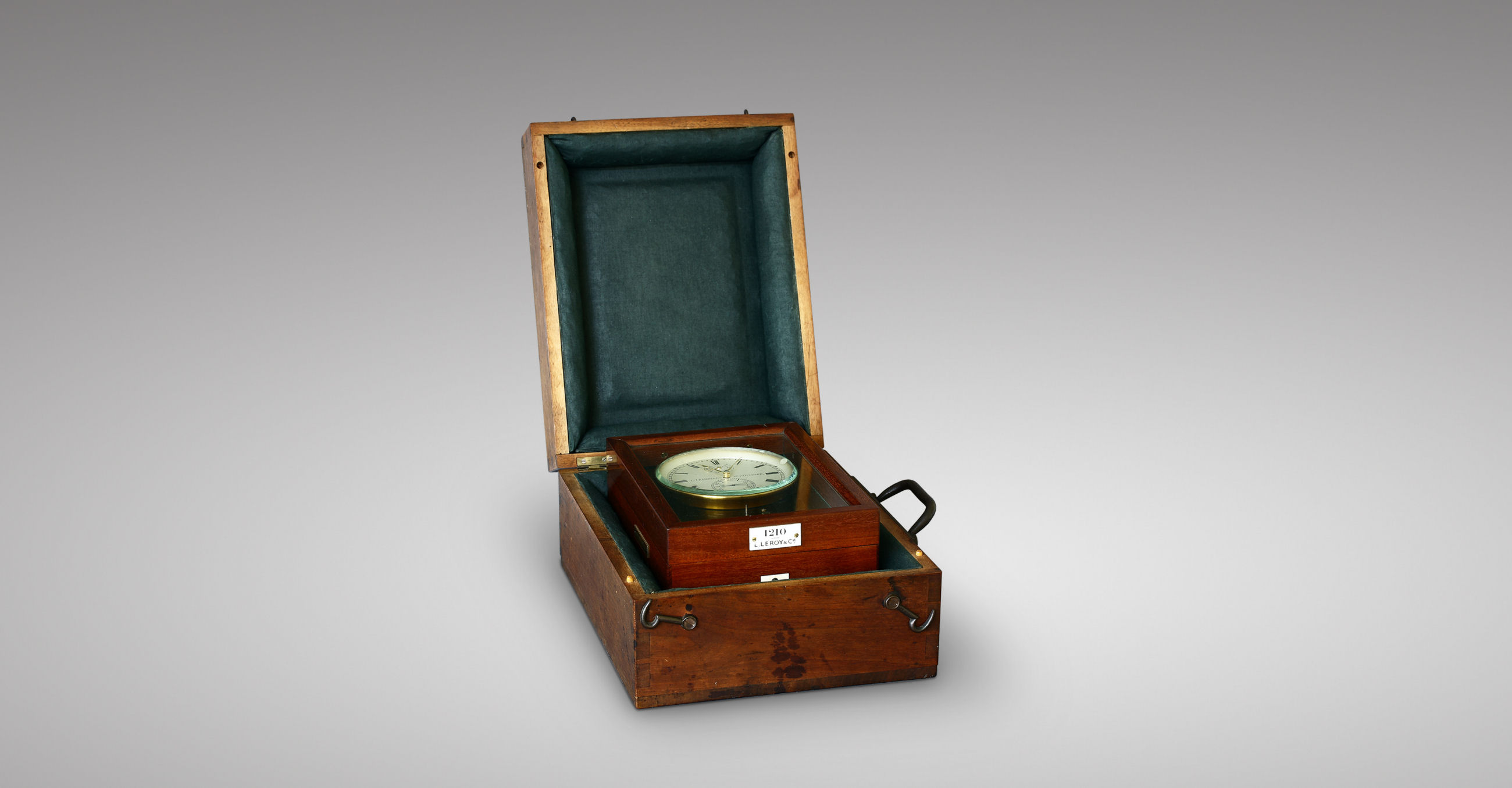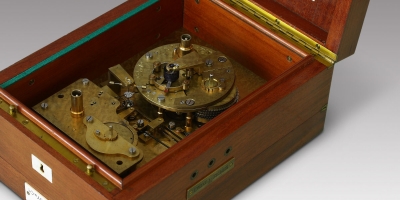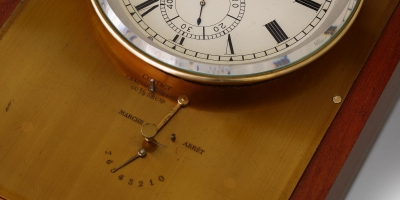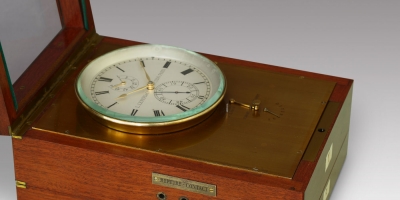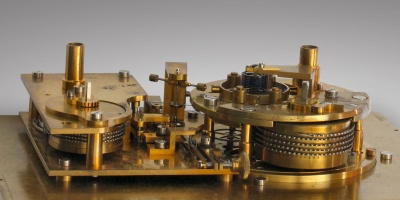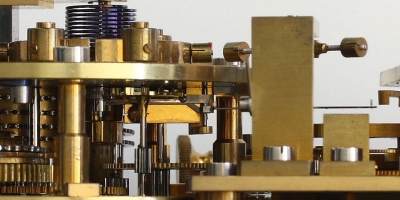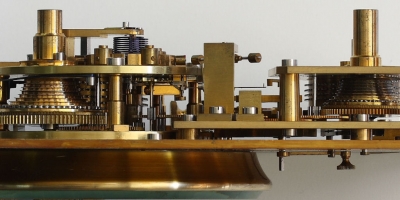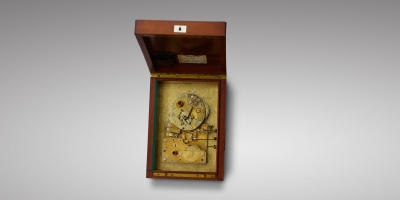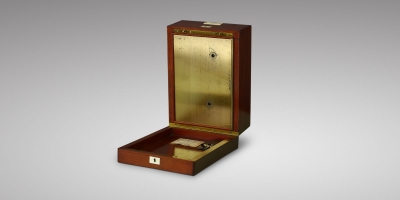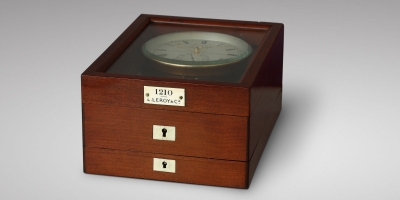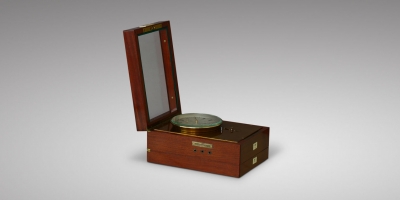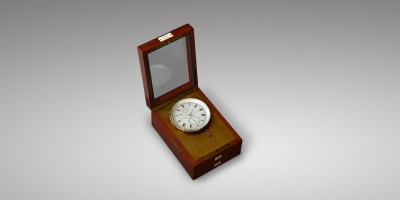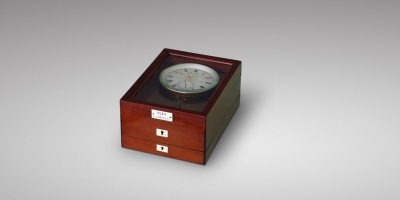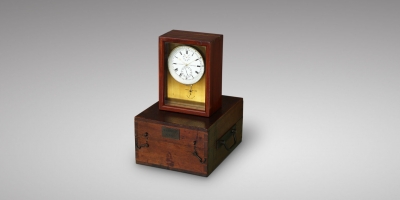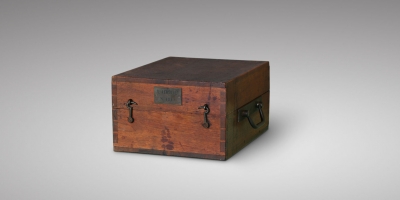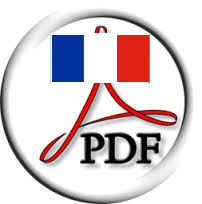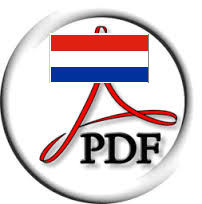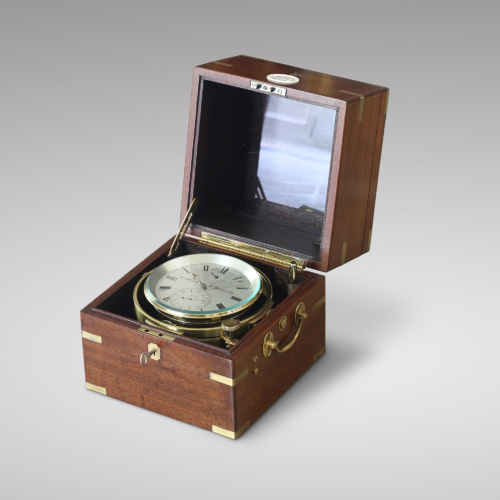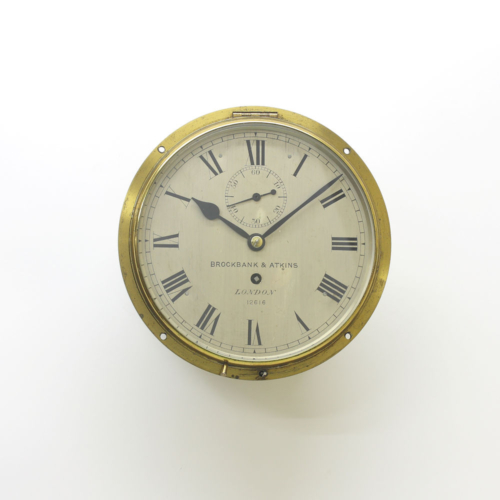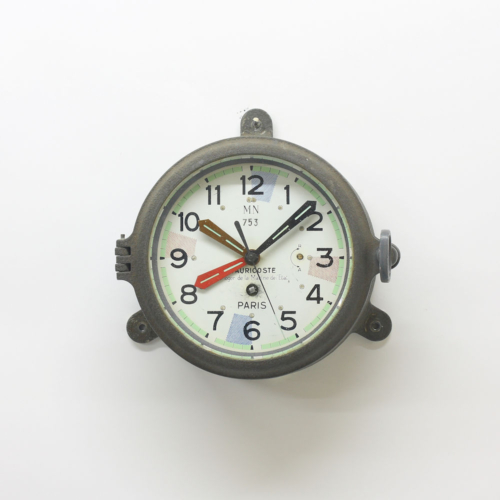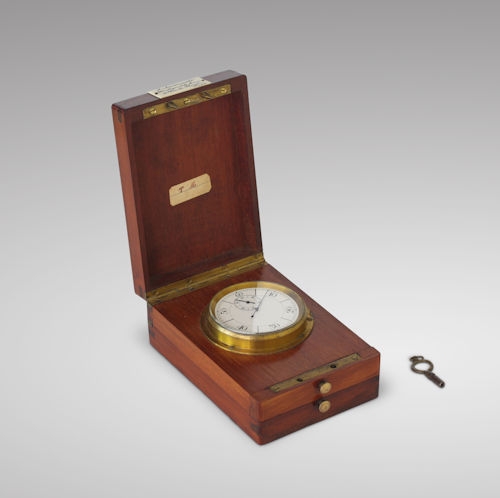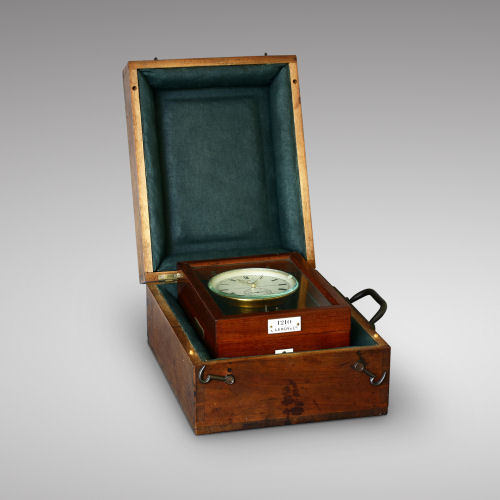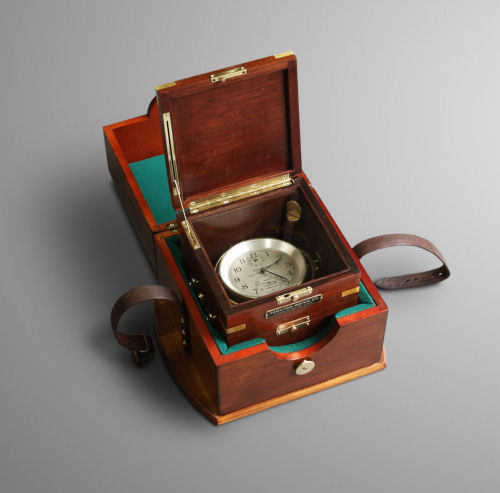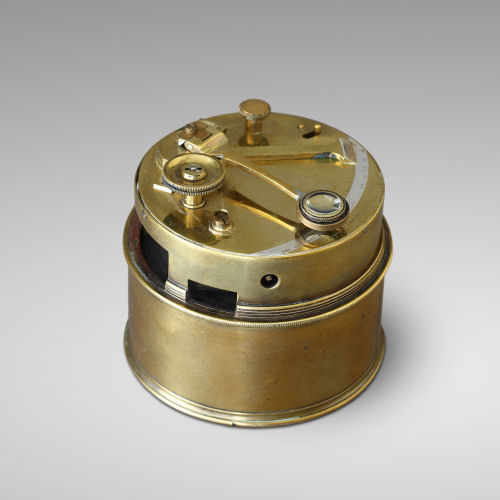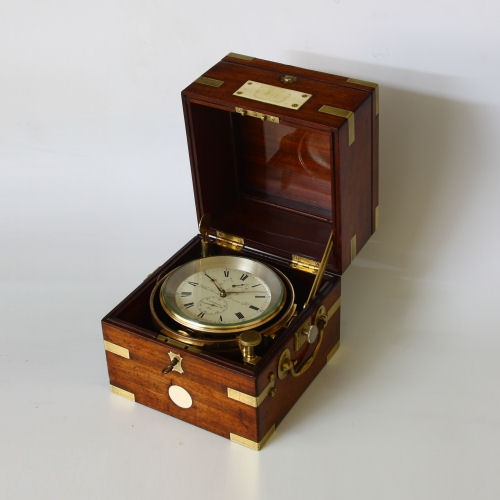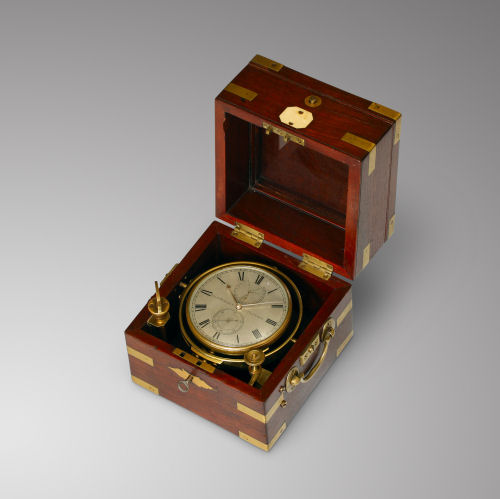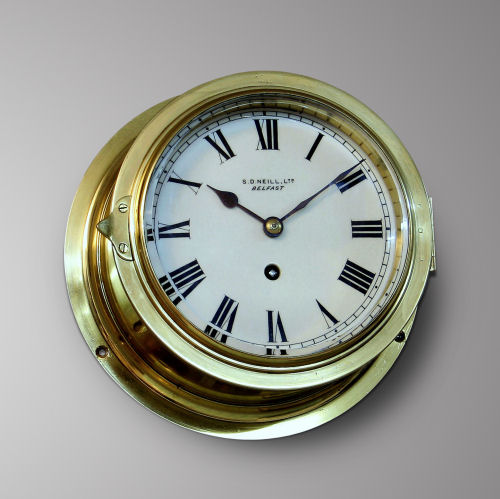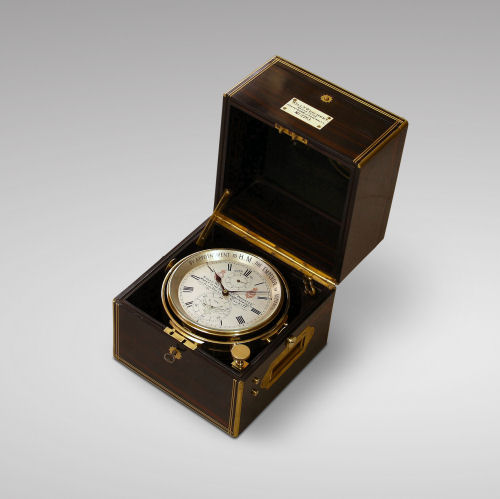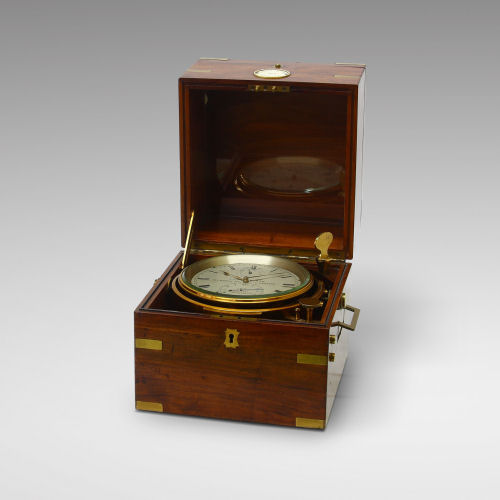Scientific and observation chronometer, sold in 1913 , signed L. Leroy 7 Bd de la Madeleine à Paris, also signed No. 1210 Leroy & Cie on an ivory panel. The main movement is of a typical marine chronometer, with silvered dial and Roman numerals, with first subsidiary dial under the numeral XII indicating the 56-hour power reserve, and second subsidiary dial above VI for the seconds. Signature and serial number in the centre. Powered by a main barrel with fusee and spring-detent escapement, it being prolonged in a square to be used as a stop-start to the additional movement specially made for the transmission of an electrical impulse every second or half-second. An ingenious cam system allows for the transmission of either an impulse or an interruption of continuous current every second or half second at will. This second movement, especially designed for this instrument, also works with fusee and chain, cams and electrical switches, and has a power reserve of 7 hours. All these special options are switchable through the front panel, just underneath the main dial. The chronometer is encased in a rectangular mahogany box with two lids. The first, with a glass panel, provides access to the dials and functions; the second provides access to a bottom compartment containing the key and space to store documents. The lower panel allows for sliding sideways with two holes for winding both movements separately. On the side are placed the three holes for the electrical contactors. Black text on ivory panel reads: No. 1210 Leroy & Cie
Presented in its original padded and numbered mahogany storage box with external handle. In very good condition and perfect working order.
Historical note: Sold by Leroy in 1913 to Thomas Mercer & Co (the pre-eminent manufacturer and retailer of marine chronometers in Great Britain) who retailed it to Mr. Ferrié.
Dimensions
H. 10.7 cm (4.2 in); W. 17.1 cm (6.7 in); D. 23.5 cm (9.3 in)
Box dimensions: H. 15.6 cm (6.1 in); W. 24.3 cm (9.6 in); D. 30.9 cm (12.2 in)
Leroy & General Ferrié
This observation chronometer made by the firm L. Leroy is characteristic of the instruments produced for marine and military use. It is also a perfect example of what was considered to be the most accurate timepiece produced by French chronometer makers during the first half of the nineteenth century. The coveted title ‘Clockmaker to the Navy’ (Horloger de la Marine) successively awarded by the King and then by the State to the most pre-eminent clockmakers, gave Leroy the equivalent recognition of ‘supreme master’ (brevet de maîtrise suprême) in the art of precision timekeeping. Leaving an indelible mark in the history of chronometry, his achievement was consecrated after obtaining 349 medals from the Besançon Observatory – a record that still stands to this day. The Leroy company archives, comprising sales records of almost 400,000 timepieces, reveal the names of thousands of clients, often famous and powerful figures. A study of the documentation concerning the ‘Production nos./Chronometers and Astronomical Clocks’, reveals that our chronometer (no. 1210) was sold on 21 May 1913 to Thomas Mercer & Co, one of the most prolific makers of luxury chronometers, and undoubtedly the most reputed firm in its day. As indicated in the records, this purchase was intended for a certain ‘Monsieur Ferrié’, who it will be shown, was, as an inventor, closely tied to the development of the prestigious firm L. Leroy, established then in the heart of the Grands Boulevards of Haussmannian Paris. After his reputation was cemented at the 1900 Universal Exhibition in Paris, Leroy turned his attention to the development of scientific, military, industrial, and sports chronometry. This led to a collaboration in 1910 between L. Leroy, the aforementioned Gustave Ferrié and the Paris Observatory, to install the first radio time signal transmission station atop the Eiffel Tower, allowing the broadcast by telegraphic code of the national reference time over an area spanning 6000 km (3728 mi). A master clock known as a ‘constant-pressure regulator’ drove the transmission system. Accurate to 1/100 of a second, protected by heavy glass domes and lowered into wells twenty-five meters deep to avoid vibrations, these timekeeping instruments were the most precise and reliable built to date. In the 1920s, they became the basis for the reference time used by the majority of national observatories worldwide, from China to the United States, as well as Switzerland.
As such, it is possible to suppose that Ferrié, just nominated president of the International Commission of Longitudes in 1912, used his Leroy chronometer to measure the precise time from the summit of the Eiffel Tower. By inventing the first regularly scheduled time service, which standardized time nationwide, this ingenious engineer, who later became general, also made it possible for ships to determine their position at sea, revolutionizing the way longitude was determined.
It is also thanks to Ferrié that in 1904 the Eiffel Tower officially became a military radiotelegraph station, and served as of 1921 as an antenna mast for broadcasting radio programs. Furthermore, these countless benefits were able to spare the now-famous monument from certain demolition; the tower was built for the 1889 Universal Exhibition in commemoration of the centenary of the French Revolution and was scheduled for demolition in 1909, when its 20-year lease expired.
GUSTAVE FERRIÉ (1868-1932)
When on 21 January 1904 the Eiffel Tower became an official wireless telegraph communications station, Gustave Ferrié was in charge of the exploration and implementation of wireless telegraph stations for military purposes, using the tower to mount antennas for long-range telegraphy. In 1914, Ferrié, then a colonel, was named director of the committee of French military radio communications (TSF), setting up a radiotelegraphy network during World War I. With the strategic role of the Eiffel Tower in Paris confirmed, another station was built in Lyon for safety reasons. Ferrié also further developed military communication research, equipped the French and Allied forces, and developed a colonial network thanks to this new communications technology. Promoted to Brigadier-General in 1919, Gustave Ferrié became General Inspector of military telegraphy and transmission services. In 1921 he received the Osiris Prize, the most prestigious prize medal awarded by the Institute de France, and in 1922 he was elected member of the Academy of Sciences. By the end of his life, he presided over thirty-two international scientific organisations. Every year, the Mayor of Paris awards the General Ferrié Prize to a researcher who has distinguished him or herself in the field of communications.
Bibliography
Tony Mercer, Chronometer Makers of the World, NAG Press 1991; Michel Amoudry, Le Général Ferrié, Presse Universitaire de Grenoble, 1993; Maison Leroy, company brochure.
Price
€ 14500.-
